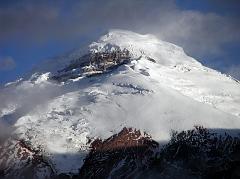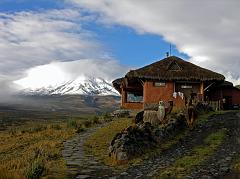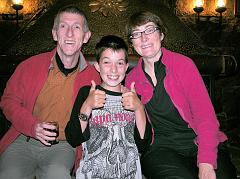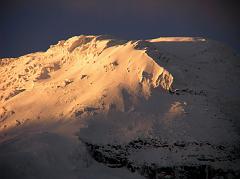
 |
Home | Cotopaxi and Chimborazo References | Contact |




Updated: May 2009. Click on an image to see the FULL size with a caption.
Please see separate sections on Quito, Ecuador and Galapagos Islands.
Ecuador gets its name from the fact that it straddles the equator. The capital is Quito (2800m), the second highest capital in the world. Ecuador's "Avenue of the Volcanoes" is a 325 km long valley with many snow-covered volcanoes, the most famous being Cotopaxi (5897m) and Chimborazo (6310m), Ecuador's highest summit. In the early 1800s, Chimborazo was thought to be the highest mountain in the world. Because of the equatorial bulge, it is in fact the highest when measured from the centre of the earth.
Located about 75km south of Quito, Cotopaxi (5897m) is the second highest mountain in Ecuador, after Chimborazo. Cotopaxi has an almost symmetrical cone that rises from a highland plain of about 3800m, with a width at its base of about 23km. It has one of the few equatorial glaciers in the world, starting at 5000m. The first ascent of Cotopaxi was made by Wilhelm Reiss and Angel Escobar on November 28, 1872.
Chimborazo, located 150km south-southwest of Quito, is the highest mountain in Ecuador at 6310m. Chimborazo has five summits - Ventimilla (6267m), Whymper (6310m, Main), Politecnico (5820m, Central) and Nicolas Martinez (5570m, Eastern). Chimborazo's majestic summit rises 2500m above the surrounding highlands. The top of Chimborazo is completely covered by glaciers with some north-eastern glacier arms flowing down to 4600m. With an elevation of 6310m, Chimborazo is just one degree south of the equator and the earth's diameter at the equator is greater than at Everest's latitude (nearly 28° north), with sea level also being elevated. So, despite being 2540m lower in elevation above sea level, it is 6384km from the Earth's center, 2.1 km farther than the summit of Everest.
Until the beginning of the 19C it was thought that Chimborazo was the highest mountain on Earth. The first ascent of Chimborazo was made by Briton Edward Whymper and the brothers Louis and Jean-Antoine Carrel via the ia the South West Ridge on January 4, 1880. As there were many critics who doubted that Whymper had reached the summit, later in the same year he climbed to the summit again choosing a different route (Pogyos) with the Ecuadorians David Beltran and Francisco Campana.